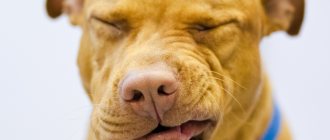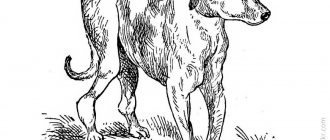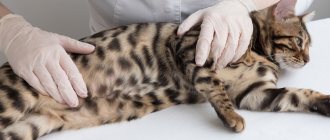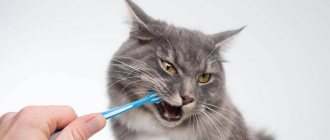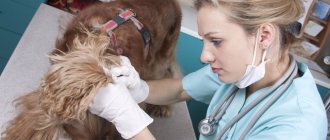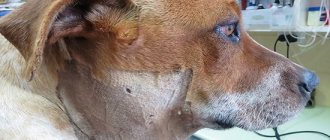Pyometra in dogs appears when problems occur in the reproductive system. The ovaries and uterine cavity are filled with purulent contents, which can come out into the abdominal cavity. Timely detection of the disease will help avoid the death of the animal. We’ll talk about what pyometra is, the first symptoms of the disease, how to treat it.
What is pyometra?
Pyometra or in other words, purulent endometritis is an inflammation of the uterine mucosa in females. The inflammatory process gradually leads to the formation of pus, which in large quantities clogs the passages of the fallopian tubes and spreads further throughout the body.
There are two types of pyometra:
- Open form. Easily diagnosed as pus flows out through the genitals.
- Closed form. It is impossible to see the accumulation of pus. As a result of the accumulation of a large amount of pus, the uterus ruptures. All the pus enters the animal's abdominal cavity, which leads to death.
Important! Pyometra in a closed form often occurs in obese females who lead a sedentary lifestyle. To save her, it is necessary to perform surgery.
Which females are in the danger zone:
- over 5 years of age;
- overweight;
- those who often produce offspring or who have never given birth;
- unsterilized individuals;
- females who show symptoms of false pregnancy.
Causes of the disease
Several conditions are necessary for the inflammatory process to occur. However, the main reason is a metabolic disorder and hormonal imbalance in the female’s body. The disease occurs if:
- During estrus, an infection occurs. For example, a male brought it in during mating.
- An increased level of progesterone, which does not decrease even after estrus for 80 days, is an excellent environment for the proliferation of bacteria.
- Weakened immunity, unable to fight viruses.
- A hormonal imbalance occurs, as a result of which cysts appear on the reproductive organs.
- Inflammation of the bladder or intestines, infection from these organs enters the uterus.
- Taking contraceptives to avoid pregnancy.
It is important to know that the development of pyometra can be promoted by infectious diseases in other internal organs, various neoplasms or cysts.
On a note! Scientists are convinced that regular use of drugs that reduce an animal’s sexual activity changes its hormonal levels, which leads to the formation of an inflammatory process.
List of drugs against the disease
| Drug name | Price | Mode of application | |
| Antibiotics | Gentamicin 4% | 135 rubles (100 ml bottle) | One dose is 0.6 ml per 10 kg of pet’s weight, the injection is administered intramuscularly 2 times a day |
| Enroflox 5% | 490 rubles (100 ml bottle) | Subcutaneous injection is administered once a day for 3-5 days at a dose of 0.1 ml per 1 kg | |
| Amoxiclav | 390 rubles (14 tablets) | Tablets are mixed into the food once a day (every 12 hours) for 5 days, dose – ¼ pill per 5 kg | |
| Prostaglandins (stimulate uterine contractions) | Enzaprost F | 5000 rubles (5 ampoules of 1 ml each) | Intravenously or intramuscularly 0.04 ml per 1 kg, timing and exact methods of application are individual |
| Dinoprost | 783 rubles per ampoule | Injected into the uterus through a catheter at a dose of 0.0005 | |
| Oxytocin | 57 rubles (20 ml bottle) | Administered intravenously or intramuscularly at a dose of 5-10 international units per dog | |
| Estrofan | 865 rubles (1 ampoule 10 ml) | The dosage is verified only based on a specific individual, a one-time intramuscular injection | |
| Dinolytic | 850 rubles (1 ampoule 10 ml) | The drug is similar to Estrofan, the dosage is determined specifically for the specific dog | |
| Antiprogestins (open the cervix, help restore the balance of white blood cells that will fight infection) | Alizin | 3200 rubles (1 bottle 10 ml) | Injected subcutaneously 2 times with an interval of 24 hours at a dose of 10 mg per 1 kg |
It is worth remembering that there is a risk group, which includes females from 4 to 8 years old. The disease is dangerous for sedentary animals with a thick fat layer and unsterilized females. In addition, females who were regularly supplied with contraceptives or drugs that reduce the activity of hormones can also be included in this category.
Symptoms of pyometra in a dog
Both forms of the disease have the same symptoms. A caring owner will pay attention to the fact that the dog vomits and often goes to the toilet with liquid feces. As a result of poisoning of the body, intoxication and dehydration occur.
Symptoms of pyometra in dogs:
- lack of appetite, increased desire to drink water;
- lethargy and apathy to the environment;
- the animal’s body temperature rises above normal and can reach 40 degrees;
- the size of the abdomen increases noticeably;
- frequent urination, even without urine;
- the loop swells, the female often licks herself under the tail;
- dark, green or bloody discharge, or pus, with a foul odor appears.
Important! The inflammatory process makes the dog passive. She lies in her place more, refuses to go for walks, and does not respond to her owner’s calls.
Symptoms and signs
The first warning signs include behavioral changes. The animal becomes lethargic and apathetic. It refuses to go for walks, eats poorly and drinks a lot. With a sedentary lifestyle and warm weather, this behavior is often ignored by the owners.
A gradually enlarging belly is also not a cause for concern. His growth is mistaken for pregnancy or weight gain.
The real excitement comes a little later, when the existing symptoms are complemented by:
- fluctuations in body temperature (a sharp jump to 40°C or a drop below normal);
- vomiting and diarrhea;
- acute pain when palpating the abdominal cavity, accompanied by whining, squealing or barking;
- swelling of the noose and frequent licking of the perineum;
- false urge to urinate;
- the appearance of foul-smelling discharge from the vulva of a strange color (green, gray, red) and consistency (flakes, thick mucus);
- cramps and muscle spasms that interfere with gait.
If any of these symptoms appear, you should be examined by a veterinarian. In some situations, emergency surgery may be required to save your pet, so you should not self-medicate until a diagnosis is made.
Diagnostics
To identify pyometra, you must contact a veterinary clinic. The doctor conducts an external examination of the animal by palpation of the abdominal wall and asks clarifying questions:
- What age is the female?
- What contraceptives were used and how often?
- Was there a false pregnancy?
- How long did the heat last?
Further diagnosis depends on the condition of the dog. The doctor prescribes an ultrasound examination, blood and urine tests, and takes a vaginal smear.
Our patients after pyometra
An 11.5-year-old Yorkshire terrier dog, Tiffany, was admitted to the Pride Veterinary Center to see a therapist in a state of depression, refusal to eat, and increased thirst.
Upon examination, purulent vaginal discharge was discovered. Ultrasound diagnostics were performed and a diagnosis of pyometra was established - purulent inflammation of the uterus, in this case with the threat of its rupture.
A decision was made to undergo surgical treatment in a short time. A pre-anesthesia examination and procedures were performed to prepare for surgery. The dog was successfully operated on by surgeon E.S. Maslova. She is currently undergoing postoperative treatment in a hospital setting.
Treatment without surgery
Treatment of pyometra in dogs is performed using two methods: operative, with surgery, and conservative, with the use of medications.
Important! The owner should know that after the operation the female will no longer be able to produce offspring.
Treatment for pyometra at home is aimed at maintaining the dog’s gastrointestinal tract in proper condition, since taking medications and surgery can lead to digestive disorders. To do this, the female is given a small dose of chamomile and fennel infusion. A syringe is used for drinking.
Drug treatment
Treatment with drugs is effective only at an early stage or in open form of pyometra. However, such treatment does not guarantee that the disease will not recur. The risk of relapse occurs in 80% of animals after 2-3 heats.
Treatment medications prescribed by the veterinarian:
- Antibiotics to fight infection: Enroflox 5%, Amoxiclav, Gentamicin 4%.
- Prostaglandins to stimulate contraction of the uterine walls: Dinoprost, Enzaprost, Oxytocin, Estrofan.
- Antiprogestins for dilation of the cervix and restoration of leukocyte balance: Alizin.
If purulent discharge is already absorbed into the blood, then drugs are prescribed that have a stimulating effect on the functioning of the kidneys and liver. Thus, pus is removed from the body faster.
About surgical and non-surgical treatment
Unfortunately, pyometra almost always leads to removal of the uterus and reproductive organs. In approximately 10% of cases, everything can be cured with medication, but the disease returns. The endometrium is too complex to create an effective concentration of antibiotics without fatal harm to health. This is due to its low permeability to this group of drugs. All accompanying problems will go away, the disease will subside for a short time, and then will be reborn with renewed vigor after about one heat. Therefore, experts strongly recommend undergoing a hysterectomy. Typically, breeders who make money from breeding the breed refuse this in order to preserve reproductive function. An animal can only survive the return of a dangerous disease no more than 2-3 times, and there is also a high risk of congenital defects in puppies.
Operation
An operation to remove the reproductive organs (uterus and ovaries) is prescribed immediately if the dog is in serious condition and there is a threat to its life.
It also makes sense to get rid of internal reproductive organs if:
- the female is not used for breeding offspring;
- there are chronic diseases or tumors that can cause uterine rupture;
- closed type pyometra.
The operation itself is performed under general anesthesia. The doctor removes the ovaries and uterine cavity of the female by cutting open the abdominal wall. After the operation, the animal remains in the clinic for 2-3 days under the supervision of specialists, in a state of clinical sleep.
An improvement in the female's general well-being occurs on the second day after the operation. After 3 weeks, the animal will be completely ready to return to normal life.
Cost of the operation
The price of surgical treatment depends on the animal’s body weight:
| Weight | Price, rubles |
| Up to 5 kg | 4000 |
| From 5 to 10 kg | 5000 |
| From 10 to 20 kg | 10 000 |
| From 20 to 40 kg | 12 000 |
| From 40 kg and above | 15 000 |
Complications
Complications may occur during the operation. Since pus accumulates in the reproductive organs, there is a risk of uterine wall rupture and fluid entering the abdominal cavity.
Other possible complications:
- a state of shock in the animal due to a sharp change in internal pressure;
- the occurrence of internal bleeding;
- the stitches may come apart, the wound may become inflamed;
- Individual intolerance in dogs to suture material, allergy to threads.
If inflammation occurs due to intolerance to threads, sutures made from material from other companies are reapplied.
Postoperative care
After such an operation, the animal needs daily care. The owner’s task is to minimize the risk of infection getting into the wound. In addition, the dog is now considered sterilized, so it needs to be given the appropriate food.
Care procedures:
- Every day, the seams are treated with Chlorhexidine disinfectant solution and Levomekol ointment.
- After the operation, the female is put on a blanket to prevent her from licking the wound and tearing the stitches. It is the owner’s task to keep the blanket clean and wash it daily.
- The dog is prescribed anti-inflammatory drugs and antibiotics. The owner must give them to the animal strictly as prescribed by the doctor and at the right time.
- In the case of a severe post-operative condition, the dog needs to be fed, its waste removed, and, if necessary, given a blood transfusion or additional IVs.
- After surgery, your dog may experience urinary incontinence.
Important! If you find an ichor in the female, or pus, thickening or swelling is leaking from the wound, or pain when touched, then immediately consult a veterinarian.
Prevention
Preventive measures are aimed at preventing the occurrence of pyometra in the dog in the future. To do this you need:
- completely eliminate the use of hormonal-based contraceptives;
- provide the dog with proper, balanced nutrition with the necessary fats, proteins and carbohydrates;
- make sure that the female is not obese;
- provide the maximum amount of physical activity;
- undergo a preventive examination by a veterinarian after the end of the estrus period and after childbirth;
- during childbirth, the place, instruments, diapers - everything must be sterile so as not to cause infection;
- ensure that during sexual activity the female does not come into contact with unfamiliar stray dogs;
- take a break between pregnancies, i.e., breed no earlier than after one or two heats.
On a note! If you do not plan to use the dog for breeding, it is recommended to carry out early sterilization.
Contagious or not to humans
Pyometra is not an infectious disease transmitted from animals to humans. Pathology occurs when physiological processes in the female body are disrupted.
However, when treating a wound or caring for an animal, you should follow the rules of personal hygiene. All procedures should be carried out wearing sterile gloves. Limit tactile contact with the sick female as much as possible.
Any discharge from the female’s genitals is a reason to consult a doctor as soon as possible. Pyometra in dogs in its advanced form can cause poisoning of the body and even death of the animal. To prevent inflammation from occurring, follow preventive measures.
At-risk groups
Since pyometra is an inflammation of the uterus, therefore, only unspayed female dogs are susceptible to it.
There are a number of factors that predispose to the occurrence of pyometra in dogs:
- dogs older than 4 years are more susceptible to developing the disease, although recently pyometra has often been recorded in 2-3 year old dogs;
- numerous estruses in a row without subsequent pregnancies or, conversely, uncontrolled frequent matings usually lead to hormonal disorders;
Avoid mating your dog too often as this could endanger his health. Photo: Thomas Stromberg
- the period after childbirth and the first few months after estrus require special attention to the bitch, since during this period the development of pyometra is most likely;
- frequent manifestations of false pregnancy after estrus are a factor indicating a hormonal disorder and signaling the possible development of pyometra;
- The constant use of hormonal contraceptives for dogs causes hormonal and endocrine disturbances, which lead to serious problems with the health of the animal.

